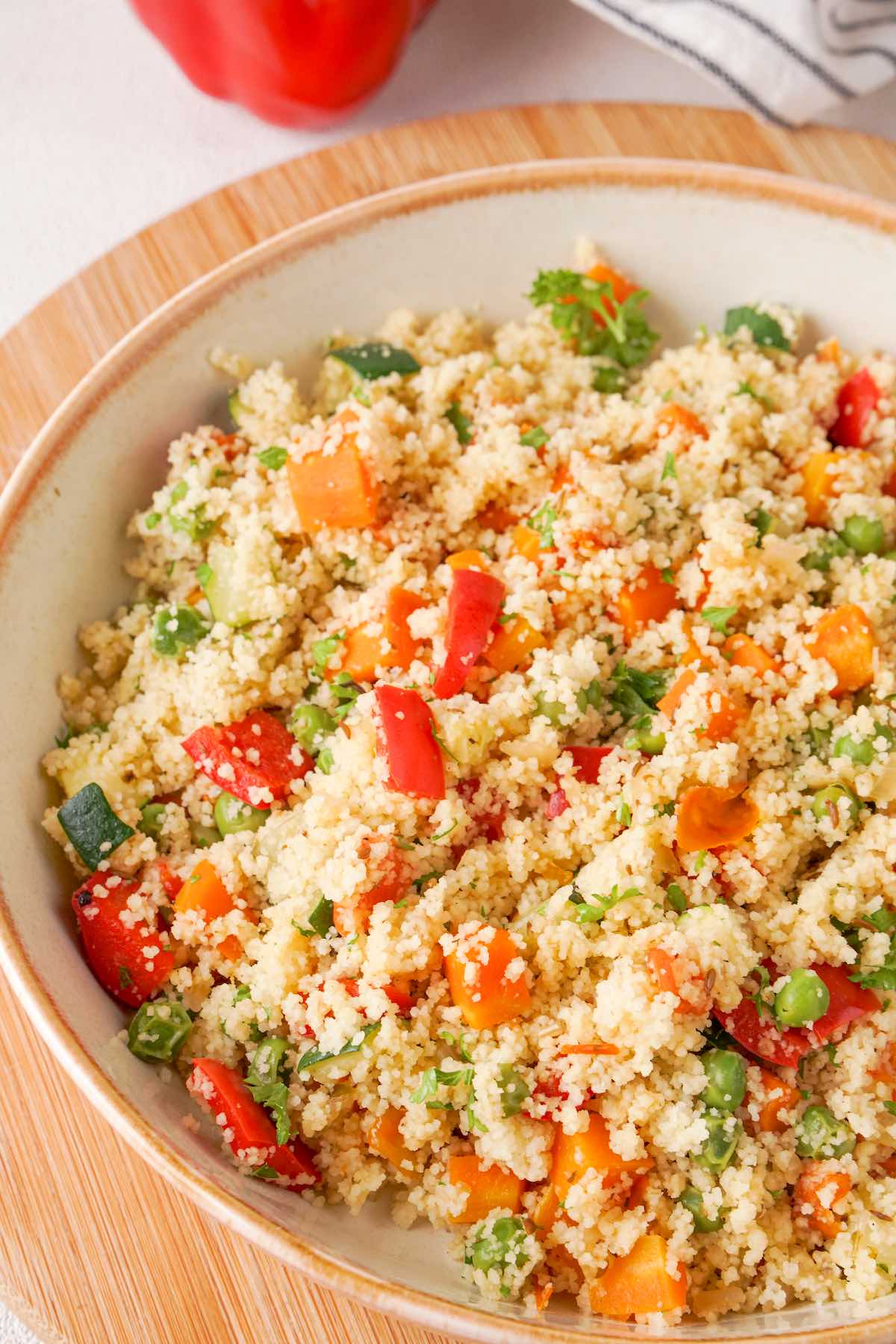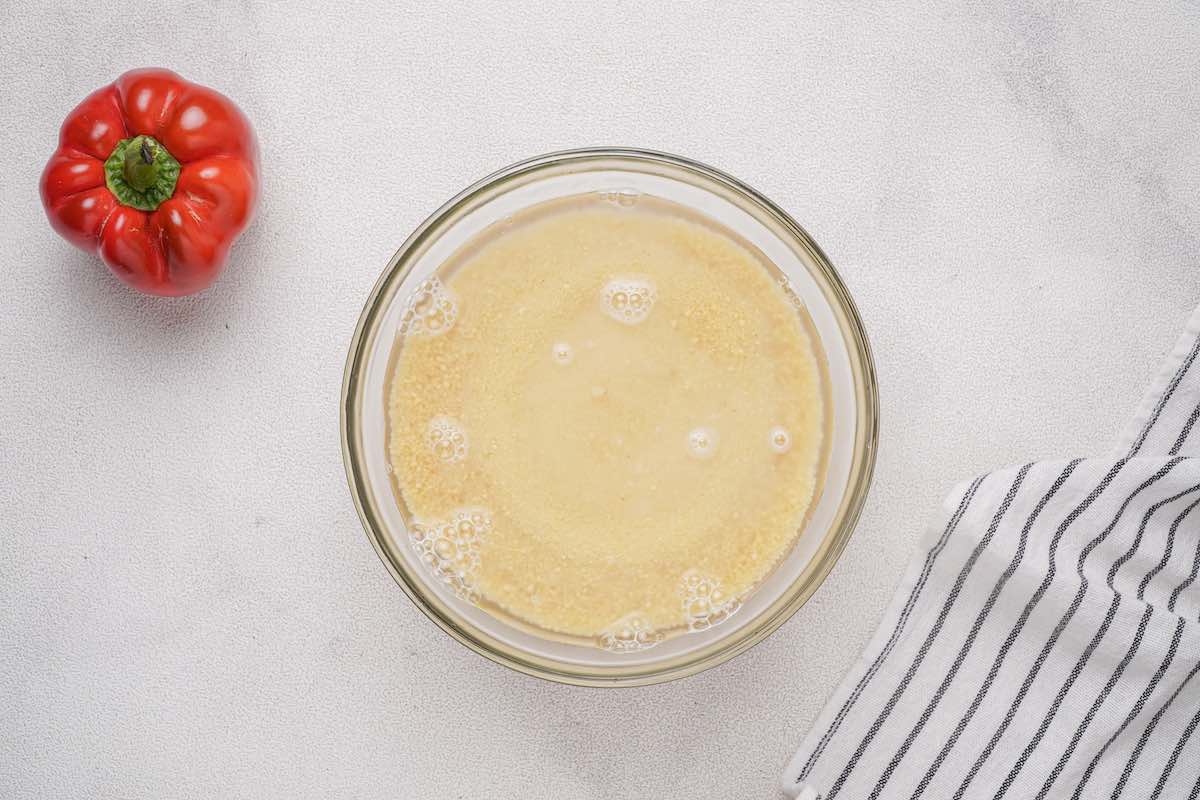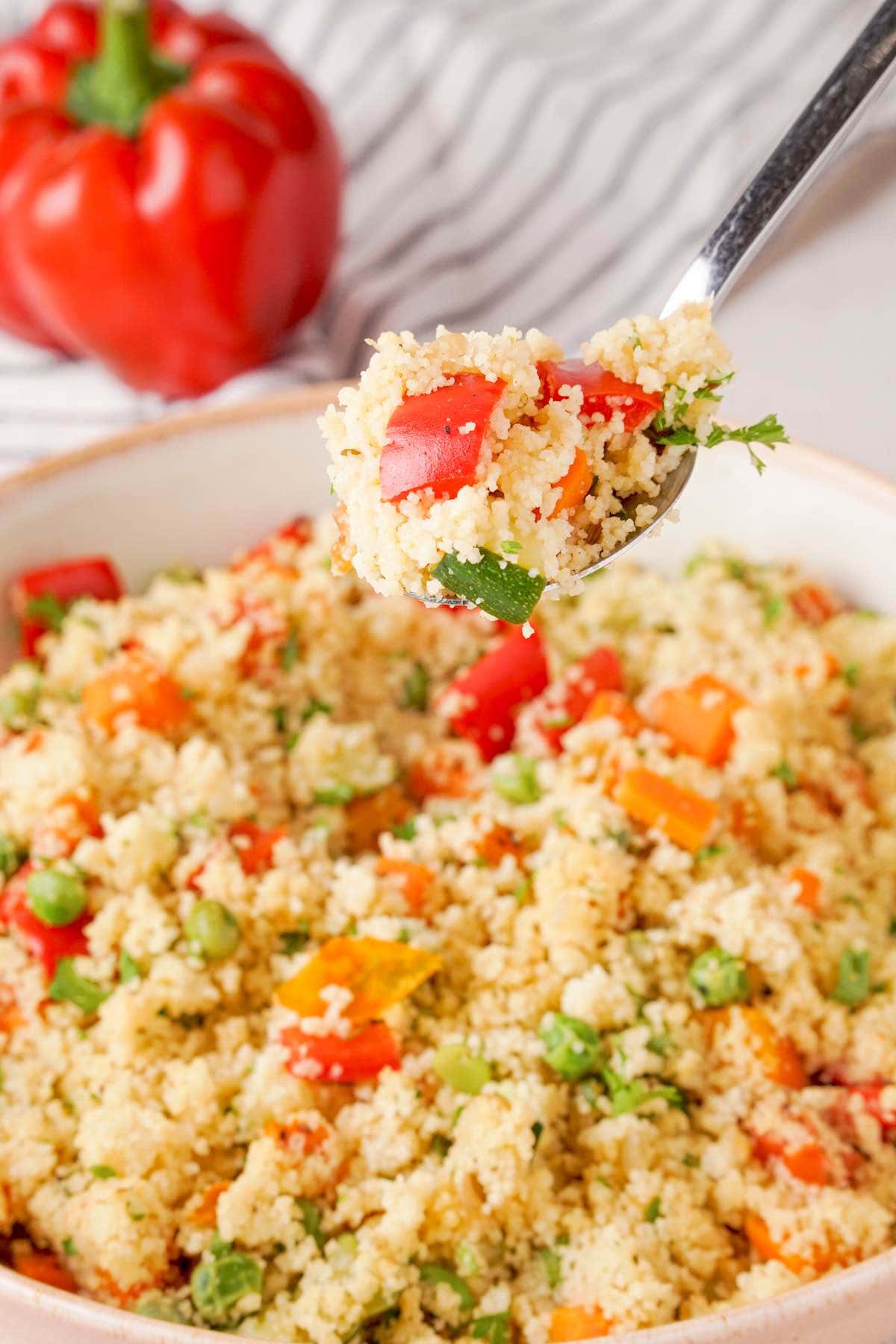How To Cook Couscous
This post may contain affiliate links. See my disclosure policy.
Learn how to cook couscous perfectly with my easy-to-memorize recipe! In just 20 minutes, you’ll have fluffy, colorful, perfectly seasoned couscous. It’s my family’s favorite side dish!
Need more side dish recipes? Learn how to cook basmati rice, coconut milk rice, or Instant Pot sushi rice next!

We’ve been adding couscous to our weekly dinner roster for years, and I for one think it’s the most versatile and underrated grain there is!
Its mild flavor acts as a blank canvas that you can season however you want. Its soft, chewy texture means it can be used interchangeably with rice or pasta, and it pairs well with all sorts of veggies and proteins.
What is couscous?
Couscous is a small wheat-based, granular type of pasta that’s popular in Mediterranean cooking. It’s typically made from durum wheat and semolina flours. The most common variety is Moroccan couscous, but you may also find Israeli couscous, which has a slightly larger pearl shape.
Table of Contents
Why I love this recipe
- Make as much or as little as you need. Once you learn the ratio (hint: it’s 1 to 1!), you can make as much as you need.
- It’s quicker than rice. Couscous absorbs moisture quickly, so if you’re strapped for time and need a filling grain STAT, couscous will be a lifesaver.
- Light and healthy. Unlike other grains, couscous is deceptively low in calories and high in fiber and plant-based protein (about 7 grams of protein per serving!).
- Customizable. When I feel my weekly meal plans have gotten a bit repetitive, this is a great way to shake things up!

Ingredients needed
- Couscous. I used pearl couscous, which is the most common kind you can get (and the generic ‘couscous’ in any mainstream grocery store).
- Stock. I prefer chicken stock, but any stock will work.
- Spices. I use cayenne pepper, smoked paprika, saffron, garlic powder, and onion powder.
- Vegetables. Use the diced vegetables of your choice. I like to add carrots, bell peppers, zucchini, and peas, and I’ll stir in spinach right before serving.
- Extra virgin olive oil. For flavor and texture.
- Salt. To taste.
- Butter. I use unsalted butter while fluffing the couscous to help create a smoother texture, but you could use more EVOO.
How to cook couscous
I’ve included step-by-step photos below to make this recipe easy to follow at home. For the full printable recipe instructions and ingredient quantities, scroll to the recipe card at the bottom of this post.

Step 1- Cook the couscous. Bring the broth to a boil, reduce to a simmer, and add oil and salt. Add the couscous, cook briefly, remove it from the heat, and set it aside until most of the liquid is absorbed.

Step 2- Sauté veggies. Add the veggies to an oiled skillet and cook until tender.

Step 3- Season. Fluff the couscous with a fork and add the seasonings. Stir in the butter.

Step 4- Assemble. Add the couscous to the skillet and stir to combine.
Can I make couscous in the microwave?
Yes, if you’re really pressed for time, you can use the microwave instead of the stovetop.
To do this, microwave the broth until very hot (about 5 minutes), then stir in the oil and salt and carefully pour it over the couscous. Cover it and let it sit for 10 minutes or until the liquid is absorbed.
Arman’s recipe tips
- Toast the couscous. Lightly toast the couscous in a dry skillet for 2-3 minutes. This will give it a slightly nutty flavor.
- Maintain the 1:1 liquid ratio. Use one cup of water or stock for every cup of couscous; this will ensure a perfect consistency if you need to scale the recipe up or down.
- Leave it alone! Once you remove it from the heat, leave it covered until all liquid has been absorbed. This means no stirring–and no peaking!
Variations
- Crunch. Top the couscous with toasted pine nuts or pistachios.
- Fresh herbs or citrus. Garnish the couscous with parsley, mint, cilantro, or fresh basil, then serve it with a squeeze of fresh lemon juice for a bright flavor.
- Dried fruit. Fold in dried cranberries, apricots, or raisins for a Mediterranean flavor.
Storage instructions
To store: Store the cooled couscous in an airtight container in the refrigerator for 3-4 days.
To freeze: Let the couscous cool completely, then freeze it in a freezer-safe container for up to 3 months.
Reheating: Reheat the couscous in a pot with a splash of water or stock and cook on medium-low heat until warm. Or, microwave the couscous with a few drops of water until warm.

Frequently asked questions
Yes, while I don’t usually follow this method, you should be able to pour boiling water over couscous, cover it with foil, and let it sit until the liquid is fully absorbed.
One dry cup of couscous should yield 2-3 cups of cooked couscous, depending on which type you’re using and how much liquid you’re adding.
One dry cup of couscous should yield 2-3 cups of cooked couscous, depending on which type you’re using and how much liquid you’re adding. Also, letting it sit too long before fluffing with a fork can affect it too.
Recipes to use couscous

How To Cook Couscous
Video
Ingredients
- 1 1/2 cups couscous
- 3 cups chicken broth
- 1 teaspoon olive oil
- 1/2 teaspoon sea salt
- 1 teaspoon cayenne pepper
- 1 teaspoon smoked paprika
- 1 teaspoon garlic powder
- 1 teaspoon onion powder
- 1 teaspoon saffron
- 2 tablespoon unsalted butter can sub for olive oil or oil of choice
- 1 cup mixed vegetables i used zucchini, bell pepper, carrots, and peas
Instructions
- In a large pot, add the chicken broth and place over medium heat. Bring it to the boil.
- Once boiling, reduce to a simmer, add the olive oil and salt, and mix well. Add the dry couscous and cook for 1-2 minutes before removing from the heat. Allow the couscous to sit for 5-6 minutes or until most of the liquid has been absorbed.
- While this is happening, saute the vegetables in a skillet until tender.
- After the liquid has been absorbed, fluff the couscous with a fork and add the cayenne pepper, smoked paprika, garlic powder, onion powder, and saffron and mix very well. Stir through the unsalted butter until the couscous is coated.
- Add the couscous to the skillet with the vegetables and mix until combined.
Notes
Nutrition
Originally updated October 2023, updated and republished November 2024














This I really needed in my life! My cous cous is favourite thing and I think I eat it 2-3 times a week. Thannks for the recipe.
We love rice here, especially jasmine rice. We also are couscous eaters and love it too. The type really doesn’t matter to my son, but I’ve found I love the Israeli type. Love those little balls of flavor. I’m not that crazy about the sweet recipes, but all the others…..YUM!
Thanks, Sharon! I love the Israeli type too- Such a delicious nutty texture 🙂
Israeli couscous is very nice: it is so large and I once had a salad with it, a light lemon vinegarette and roasted vegetables. It was delicious.
This looks lovely. I think eggplant strips or pressed tofu that was dry rubbed with spice might work for a veggie option.
Oh wow, LeAnn that sounds delicious- I’m working on an antipasto version!
Eggplant strips and tofu? YES PLEASE.
Dinners that come together this quickly are my absolute favorite. This looks delicious.
Thanks so much, Christine- You and me both!
I bet this dish would be amazing with just about any protein, Arman! It’s so packed with flavor, too. Awesome recipe!
Thanks for your kind words, Becca. I bet this would go well with…I don’t know, some peanut butter DIP 😉
Couscous is one of those grains where whenever I eat it, I wonder why I don’t do it more often. It’s fast, easy, has great flavor and holds up well with other veggies. This sounds fantastic and your pictures came out beautifully.
Thanks my dear 🙂
I love paella and all Spanish food!! This looks yummy!!
I think the grain that was made most often in my household by my mom, was white rice. I have definitely branched out to different types of grains as I have gotten older. I like quinoa a lot because of the nutty taste. It’s so filling, too!
I need to start bringing quinoa back in action! Spanish food (Especially seafood!) is so good!
I’ve ALWAYS wanted to make paella!! ALWAYS – gotta try it with spaghetti squash or cauliflower – ASAPPPPer-rooo!
If you moved to LA….. WE COULD MAKE IT TOGETHER—- HUBBY! lol
YES! I’d totally Gigi this recipe up!
The staple grain in my house was spaghetti or white rice. My mom was a real trailblazer on that front. I think the grain I have learned to appreciate as of late is pearled couscous. It’s like big round balls of pasta. I like the way they feel in my mouth ahaha
I love pearled couscous- So good!
I love couscous but always forget about it! …or maybe I just like saying couscous. Couscous.
Hahahaha just like I love saying Pittsburgh. Pittsburgh.